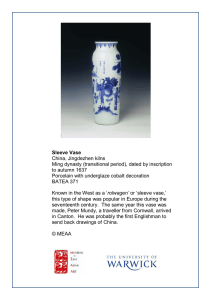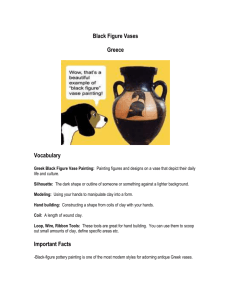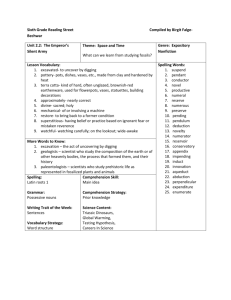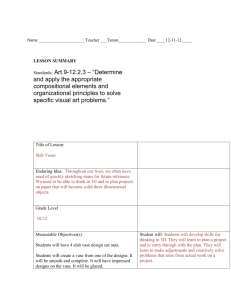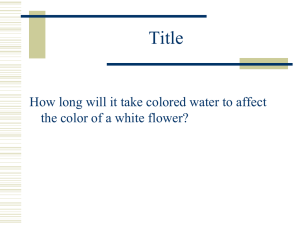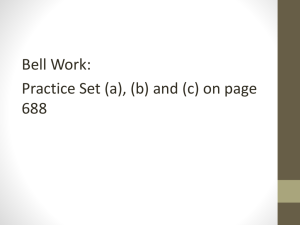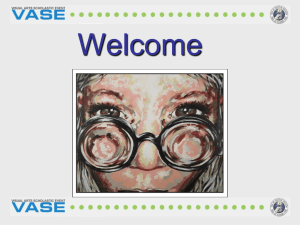An Immersive Environment for the Vase Museum
advertisement
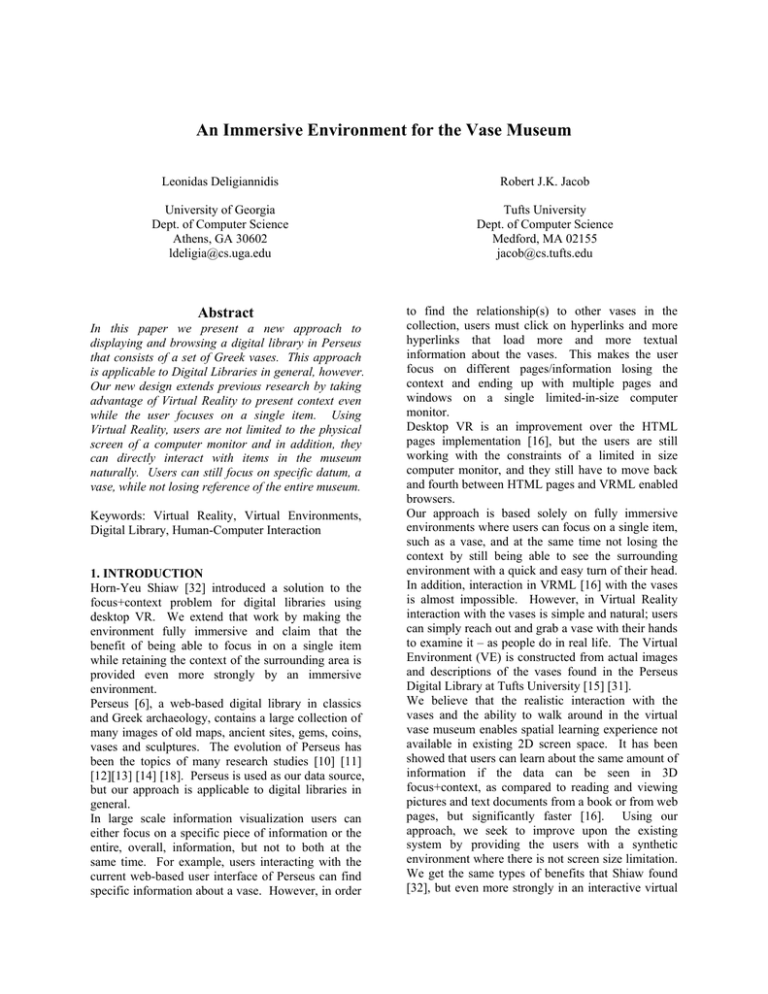
An Immersive Environment for the Vase Museum Leonidas Deligiannidis Robert J.K. Jacob University of Georgia Dept. of Computer Science Athens, GA 30602 ldeligia@cs.uga.edu Tufts University Dept. of Computer Science Medford, MA 02155 jacob@cs.tufts.edu Abstract In this paper we present a new approach to displaying and browsing a digital library in Perseus that consists of a set of Greek vases. This approach is applicable to Digital Libraries in general, however. Our new design extends previous research by taking advantage of Virtual Reality to present context even while the user focuses on a single item. Using Virtual Reality, users are not limited to the physical screen of a computer monitor and in addition, they can directly interact with items in the museum naturally. Users can still focus on specific datum, a vase, while not losing reference of the entire museum. Keywords: Virtual Reality, Virtual Environments, Digital Library, Human-Computer Interaction 1. INTRODUCTION Horn-Yeu Shiaw [32] introduced a solution to the focus+context problem for digital libraries using desktop VR. We extend that work by making the environment fully immersive and claim that the benefit of being able to focus in on a single item while retaining the context of the surrounding area is provided even more strongly by an immersive environment. Perseus [6], a web-based digital library in classics and Greek archaeology, contains a large collection of many images of old maps, ancient sites, gems, coins, vases and sculptures. The evolution of Perseus has been the topics of many research studies [10] [11] [12][13] [14] [18]. Perseus is used as our data source, but our approach is applicable to digital libraries in general. In large scale information visualization users can either focus on a specific piece of information or the entire, overall, information, but not to both at the same time. For example, users interacting with the current web-based user interface of Perseus can find specific information about a vase. However, in order to find the relationship(s) to other vases in the collection, users must click on hyperlinks and more hyperlinks that load more and more textual information about the vases. This makes the user focus on different pages/information losing the context and ending up with multiple pages and windows on a single limited-in-size computer monitor. Desktop VR is an improvement over the HTML pages implementation [16], but the users are still working with the constraints of a limited in size computer monitor, and they still have to move back and fourth between HTML pages and VRML enabled browsers. Our approach is based solely on fully immersive environments where users can focus on a single item, such as a vase, and at the same time not losing the context by still being able to see the surrounding environment with a quick and easy turn of their head. In addition, interaction in VRML [16] with the vases is almost impossible. However, in Virtual Reality interaction with the vases is simple and natural; users can simply reach out and grab a vase with their hands to examine it – as people do in real life. The Virtual Environment (VE) is constructed from actual images and descriptions of the vases found in the Perseus Digital Library at Tufts University [15] [31]. We believe that the realistic interaction with the vases and the ability to walk around in the virtual vase museum enables spatial learning experience not available in existing 2D screen space. It has been showed that users can learn about the same amount of information if the data can be seen in 3D focus+context, as compared to reading and viewing pictures and text documents from a book or from web pages, but significantly faster [16]. Using our approach, we seek to improve upon the existing system by providing the users with a synthetic environment where there is not screen size limitation. We get the same types of benefits that Shiaw found [32], but even more strongly in an interactive virtual environment (IVE). For example, this would help a user remember where their body was when they saw a vase far back in a corner and thereby help remember how that vase fits into a larger timeline or other arrangement in the virtual museum room. In addition, users can feel that they are present in the environment and with realistic interactions they can focus on a specific item, a vase, and naturally manipulate a vase to learn the details of it. 2. BACKGROUND AND RELATED WORK Currently in Perseus, users use a web browser to browse and learn about the vase collections. This involves branching out to multiple pages, reading text descriptions, and viewing 2D images of the vases. Desktop VR is an improvement over the conventional ways of acquiring information [16] but we believe there is a better way of browsing the vase collection that also solves the problem of focus versus context. We do need a better way of browsing the digital collection for several reasons. The vases are beyond the reach of the real museum visitors, in order to provide the safety of the archeological findings, and so a digital library provides an alternative solution to information visualization [26]. However, in Perseus there are vases with only a single corresponding picture, and other vases have multiple pictures from different angles. Users must rely on textual description to gain a mental model of a vase. Sometimes long web pages are involved to describe the details of vases such as the opening of a vase, the handles, the number of handles, the artwork, weight, etc. The bigger problem is that when the users begin browsing and branching out to more pages for more information they cannot maintain focus effectively without losing the context (the collection of the vases and relational reference with other vases). impossible to implement, but at least the users can obtain in a single glance the details of a 3D modeled vase; number of handles, opening, and the look of a vase. Currently, users can get a main page of the vases, figure 1, where they have to scroll down, read text, and then follow hyperlinks to obtain more information. An alternative to this is the thumbnail representation of the page as shown in figure 2. But again, users have to scroll down to read text and try to figure out which link will bring them to the right page. It seems that the thumbnail representation is a good approach to maintain focus and context since it follows the paradigm of a zoom-able browser [3] [5] [23]; click on thumbnail to see higher resolution pictures and textual information about the vase of interest. Figure 2. Thumbnail of the Greek Vases Desktop VR solves the focus versus context problem as it is shown in [16]. The entire museum is modeled, and with a VRML capable browser users can navigate in the museum, and click with a mouse on a vase to load either an HTML page with textual information of the vase of interest, or another page with the single vase in another VRML capable browser where users can interact with the vase, figure 3. Figure 1. Collection of Greek Vases in Perseus In desktop VR the problem of focus and context is solved [16] but direct interaction with vases is Figure 3. Vase manipulation in VRML However, navigation and interaction is not natural and can take the user’s focus on the new browsers with the textual information about the vase, or the single model of the vase that the user can interact with, losing the context, the rest of the museum and the relation among the rest of the vases in the museum. Current direct manipulation techniques provide a significant improvement of the user interface (UI) design over the command-line systems [1] [2] [7] [8] [19] [24] [27] [28] [29] [30] [33]. With direct manipulation users do not have to remember cryptic commands that must be typed in on a console window. With Graphical User Interfaces (GUI) user can recall relevant command by simply mouseclicking on menus, buttons, scroll areas, etc. That is why direct manipulation is heavily utilized in digital libraries. However, the main problem is that this paradigm introduces the focus versus context problem in digital libraries. Desktop VR is an appropriate approach for browsing the digital library because it utilizes direct manipulation and also solves the problem of focus versus context. However, navigating in the synthetic environment is not natural; using a 2D device such as a mouse (or the keyboard) to navigate in a 3D environment is awkward and confusing to the users. That is why such systems have been referred to as 2½D or 3Dlike systems as opposed to 3D [4] [22]. Additionally, manipulating and interacting with the vases themselves is difficult to implement and could also work against the solution to the focus versus context problem that we are trying to solve to begin with. On the other hand, Immersive Virtual Reality (IVE) could be an ideal environment for spatial tasks, such as the Perseus Vase Museum [9] [20] [21]. IVE requires non-conventional equipment but seems to provide a better solution to the focus versus context problem. In an IVE, users can navigate in the virtual museum by making certain gestures and interact with the vases directly; simply reach out and grab a vase, rotate it to see the other side and examine it closely as people do in real life. The biggest advantage of IVE over desktop VR is that in IVE users get the feeling of being there and also not losing context; users can examine a vase while they still see the rest of the vases in the surrounding. Implementing a highly interactive environment such as this involves not only special equipment, but also a tremendous amount of programming effort, but the results are worth the effort. We should note here that in the future the users might actually feel the weight of vases and their curves with special force feedback devices within the same virtual environment, but we did not implement this feature in our prototype. 3. VIRTUAL VASE MUSEUM The Virtual Environment is a VRML file which consists of 157 3D vase models, walls, ceiling, and the roof. By providing the 3D models of the vases to the user, we eliminate the need to describe the appearance of the vases with text. Currently users can click on a 2D image on a web browser to get a higher resolution of a vase (web based version). An improvement to this was introduced [16] where users can still click on a 2D image but a new browser loads the 3D model of the vase in a VRML capable browser where users can interact with the 3D model of the vase (VR desktop version). Our implementation extends the VR desktop version into an immersive Virtual Reality environment where users can walk up to a vase and simply grab the vase with their hand(s) to manipulate it, as they would do in real life. Figure 3 shows how the users can move and rotate the 3D vase to study it in a VRML enabled browser using the mouse. To do this, the users have to click on a 2D hyperlink image in a browser that loads the 3D VRML model. This takes the user’s focus to the 3D model. In contrast, figure 4 shows how a fully immersed person is directly manipulating the vase within the virtual environment in real time, as he/she would in real life; focusing on the vase but without losing the context; the user can still see where the other vases are located in the VE with respect to the user’s and the vase’s position and orientation. Figure 4. Vase manipulation in VR The vases are constructed from 2D drawings of photographs, JPEG images and 3D models. The 3D models are texture-mapped with the JPEG images to show the appearance of the vases. The models are designed so that the inside of a vase is visible. 4. THE PROTOTYPE We implemented the prototype using Java3D and the JWSU toolkit [25], which is built on top of Java3D. For 3D tracking we utilized a Polhemus Fastrak; tracking the head and the two hands of the user. We also used two PinchGloves to activate the gestures/postures. A stereo Head Mounted Display (HMD) was also utilized. The 3D environment, the vase museum, was designed in VRML that we then loaded into Java3D utilizing the VRML Java3D loader from [17]. In the Virtual Environment (VE) the users are able to navigate with simple gestures and also interact with the environment in real time, picking up the vases rotate them look inside, etc. The internal state machine of the application is shown in figure 5. Increase speed Decrease speed FLY IDLE DRIVE The user can grasp a vase with one hand and hand it over to the other hand; JWSU supports two-hand interaction. A pinch of the left hand’s thumb and ring fingers decreases the speed of travel; a pinch is defined by touching two fingers followed by their release as depicted in figure 5. A pinch of the left hand’s thumb and middle finger increases the speed of travel. The Fly mode allows users to fly over the vase museum to see the museum from a bird’s eye view. Figure 6 show a bird’s eye view of the museum. “Drive” allows the users to travel around the museum while their feet remain on the floor. A release of the fingers in the FLY and DRIVE mode deactivates the navigation function. While the users are in the IDLE state, they can interact with the vases using one or both hands. The users can simply reach out and grab a vase (using the gestures shown in figure 5 IDLE – INTERACT state transition) in which case the vase follows the position and orientation of the user’s hand. Because of the very complex geometries of the vases and the heavy use of texture mapping, we were able to get 10 to 15 frames per second, which is just acceptable, by many researchers, for immersive environments. We utilized the version of Java3D that is built on top of DirectX. OR OR INTERACT Figure 5. State Machine The users can use the right hand to navigate in the virtual vase museum and use the left hand to control the speed of travel. However, the users can use either or both hands to manipulate the vases. Figure 7. Textual information The users could also walk close to the base of a vase, as shown in figure 7, to read and learn the details of a vase of interest. Unfortunately, due to the low resolution of the Head mounted Displays (HMD) in general, reading text while being immersed in a VE is a difficult task. However, as technology progresses and high resolution HMDs become available, reading text while being immersed should be the same as reading text of a computer’s monitor. Figure 6. Bird’s eye view of Museum 4.1. User Interaction The 3D models of the vases were stored in individual VRML files. A master VRML file X-References all the individual VRML files. The master VRML file includes position and orientation of each vase, the bases where each vase is sitting on and where the textual description of the vase is texture-mapped onto it, the columns where the vases with their bases are sitting on, walls, the roof, and the ceiling. To implement an interactive application where users can reach out and manipulate the vases, we needed to locate two things. The first one is the geometry objects in the scene graph so we can check for intersections of the user’s virtual hand(s) and the geometry of the vases, and second the matrix that describes the position orientation of a vase in space. Appearance of original master VRML file Static Environment Normal Load corresponding matrix (TranformGroup in Java3D). However, since we do not know which geometry specifies a vase, or a wall, or the base of a vase, users could manipulate any object that contains geometry. To solve this problem and enable the users to only manipulate the vases themselves we pre-processed the master VRML file to generate two VRML files and show in figure 8. Using external tools, we loaded the original master VRML file and we removed all the vases. This gave us the static Virtual Environment; the environment where the users cannot modify or manipulate with their hands. Then we reloaded the master file and we removed everything but the vases. This gave us the environment that the users are allowed to modify. Then, we loaded both of the files at exactly the same position orientation in the application. We loaded the first file statically, without tagging the geometries and their corresponding matrices; this is the Normal load shown in figure 8. Then we loaded the dynamic environment where we did tag the geometries with their corresponding matrices. The result is that the Virtual Environment appears exactly as it used to appear when we loaded the original master file, but the users can only manipulate the vases and nothing else. Dynamic Environment Enabled Drag Load Final appearance of the Virtual Environment after loading both (the static and dynamic) environments. Appearance is the same as the master file. Figure 8. Loading the Virtual Environment We can parse the VRML loaded scene and mark each geometry object (Shape3D in java3D) with its 5. USER REACTIONS We demonstrated the finished version of the prototype to the 15 students of the Virtual Reality class at the University of Georgia. We collected their informal comments as they were experimenting with the navigation and interaction techniques. The major observations were that they found annoying that they had to be reminded all the time to learn the appropriate gestures to increase and decrease the speed of travel. They also sometimes confused the drive and the fly activation gestures. Interaction however, seemed very realistic and their comments about that were uniformly positive. All the students complained that reading text while being immersed was almost impossible. The biggest complaint by all students was that the frame rate sometimes dropped too low. Most of the time the frame rate was between 10 and 15 frames per second, but, depending on the angle of the view (how geometrically complex the view was) it sometimes dropped to 2-4 frames per second. This could be solved by better video cards or by simplifying the meshes of the vases. 6. CONCLUSIONS In this paper we presented an approach on solving the focus verses context problem in digital libraries. We are extending previous research done in [16] [32 by solving the same problem in a different way, by utilizing highly interactive Immersive Virtual Environments. Using this approach, users can learn about the vase museum by immersion and direct manipulation in a natural way. Users can focus on a specific vase of interest without losing context of the entire collection. We showed the loading technique we used to make the environment interactive, which involved pre-processing a master VRML files that produced two VRML files. One of the files represents the environment that is not manipulateable and the other file that is. The realism of the museum can be improved by high resolution texture maps, advanced modeling techniques, and more accurate measurements of the 2D images of the vases. Since it is difficult to read textual information utilizing current Head Mounted Display technologies, users may need to already read the textual description of the vases before they become immersed. As a result, our approach could be characterized as an addon tool to the existing Perseus Digital Library instead of a replacement. 7. ACKNOWLEDGMENTS We thank Horn-Yeu Shiaw for her collaboration in this work, for providing the VRML files on which our virtual environment is based, and for her comments and guidance. We also thank Gregory Crane, founder of the Perseus Digital Library, for his support and collaboration throughout our work. And we thank the students at the University of Georgia who served as our first usability testers. This work grows out of a collaborative project among the HCI groups in the Computer Science Departments at UGA and Tufts, the Perseus group in the Tufts Classics Department, the Tufts Psychology Department, and the Digital Collections and Archives Group at Tufts. This research was principally supported by the National Science Foundation (NSF) and National Endowment for the Humanties under the Digital Libraries Initiative Phase 2 Program. It was also supported in part by the NSF Interactive Systems Program, Office of Naval Research, Berger Family Fund, the Tufts Selective Excellence Fund, and the Office of Instructional Support and Development at UGA. REFERENCES [1] B. Shneiderman. (1983). “Direct Manipulation: A Step Beyond Programming Languages,” IEEE Computer, 16(8), 57-58. [2] Benbasat and P. Todd. (1993). “An Experimental Investigation of Interface Design Alternatives: Icon vs. Text and Direct Manipulations vs. Menus,” Int’l Journal of Man-Machine Studies. 38:369-402. [3] C. Ahlberg and B. Schneiderman. (1994b). “Visual Information Seeking Using the FilmFinder,” In ConferenceCompanion of CHI’94, ACM Conference on Human Factors in Computing Systems. 433 [4] C. Johnson. (1998). “On the Problems of Validating Desktop VR,” In H. Johnson, L. Nigay & C. Roast (Eds.), People and Computers XIII (Procs. of HCI’98). Springer: London. 327338. [5] C. Plaisant, D. Carr, and B. Shneiderman. (1995). “Image-Browser Taxonomy and Guidelines for Designers,” IEEE Software, 12(2):21-32. [6] Crane, G. R. (Ed.) The Perseus Project. http://www.perseus.tufts.edu/, Tufts University, Medford, MA. 2003. [7] D. A. Carr, N. Jog, and H.P. Kumar. (1994). “Using Interaction Object-Graphs to Specify and Develop Graphical Widgets,” Technical Report CS-TR-3344. University of Maryland. [8] D. A. Henderson, Jr., and S. K. Card. (1986). “Rooms: The Use of Multiple Virtual Workspaces to Reduce Space Contention in a Window-Based Graphical User Interface,” ACM Transactions on Graphics, 5(3 Jul.), 211-243. [9] D. A. Norman. (1991). “Cognitive Artifacts,” In J. Carroll (Ed.), Designing Interaction, Cambridge University Press, NY. [10] D. Neuman. (1991). “Evaluating Evolution: Naturalistic Inquiry and the Perseus Project,” Computers and the Humanities, 25. 239-246. [11] E. Mylonas (1993). "The Perseus Project," In Scholarly Publishing on the Electronic Networks: The New Generation: Visions and Opportunities in Not-for-Profit Publishing: Proceedings of the Second Symposium, ed. Ann Okerson, 81-88. Washington, DC: Office of Scientific and Academic Publishing, Association of Research Librarie. [12] G. Crane and E. Mylonas. (1998). “The Perseus Project: An Interactive Curriculum on Classical Greek Civilization,” Educational Technology, 28. 25-32. [13] G. Mar.ionini and G. Crane (1994). “Evaluating Hypermedia and Learning: Methods and Results from the Perseus Project,” ACM Transaction on Information Systems, (12): 5-35. [14] G. R. Crane. (1996). “Building a Digital Library: the Perseus Project as a Case Study in the Humanities,” In Proceedings of 1st ACM Int’l Conference on Digital Libraries, 3-10. [15] G. R. Crane. (Ed.). (1992). “Perseus 1.0: Sources and Studies on Ancient Greek Culture,” Yale University Press, New Haven. CD-ROM [16] H.Y. Shiaw, R.J.K. Jacob, and G.R. Crane, "The 3D Vase Museum: A New Approach to Context in a Digital Library," Proc. JCDL 2004 Joint Conference on Digital Libraries, 2004. [17] Home page of Xj3D http://www.xj3d.org [18] J. E. Hughes. (1998). “The Perseus Project: Implications for Learning and Teaching,” Ph.D. Educational Psychology, Michigan State University. Able Media. [19] J. Nielsen. (1993). “Noncommand User Interfaces,” Comm. ACM, 36(4): 83-99. [20] J. W. Regain, W. L. Shebilske, and J. M. Monk, (1992). “Virtual Reality: An Instructional Medium for Visual-Spatial Tasks,” Journal of Communication, 42(4), 136-149. [21] K. Pimentel and K. Teixeira. (1993). “Virtual Reality: Through the New Looking Glass,” 1st Edition, Intel® / Windcrest® / McGraw-Hill Inc. [22] K. W. Authur, K. S. Booth, C. Ware (1993). “Evaluating 3D Task Performance for Fish Tank Virtual Worlds,” In ACM Transactions on Information Systems, 11(3): 239-265. [23] L. E. Holmquist. (1997). “Focus+Context Visualization with Flip Zooming and Zoom Browser.” In Proceedings of Conferenceof Human Factors in Computing Systems (Atlanta, Georgia USA). ACM CHI’97, 263-264. [24] L. Staples. (1993). “Representation in Virtual Space: Visual Convention in the Graphical User Interface,” In Proceedings of INTER-CHI’93, ACM Conference on Human Factors in Computing Systems. 348-354. [25] Leonidas Deligiannidis, Gamal Weheba, Krishna Krishnan, and Michael Jorgensen, "JWSU: A Java3D Framework for Virtual Reality", Proc. of the International Conference on Imaging Science, Systems, and Technology (CISST03), June 2003. [26] M. Beard. (1991). “Looking at Greek Vases,” Adopting an Approach II, In T. Rasmussen & N. Sivey (Eds.), Cambridge University Press, 12-25. [27] R. J. K. Jacob, L. Deligiannidis, and S. Morrison. (1999). “A Software Model and Specification Language for Non-WIMP User Interfaces,” ACM Transactions on Computer-Human Interaction, Mar., 6(1): 1-46. [28] R. J. K. Jacob. (1986). “A Specification Language for Direct Manipulation User Interfaces,” ACM Transactions on Graphics, 5(4): 283-317. [29] R. Spence. (1993). “A Taxonomy of Graphical Presentation,” In INTERACT ’93 and CHI’93 ConferenceCompanion, ACM Press, 113-114, 1993. [30] S. F. Roth and J. Mattis. (1990). “Data Characterization for Intelligent Graphic Presentation,” In Proceedings of CHI’90, ACM Conference on Human Factors in Computing Systems, NY. 193-200. [31] S. K. Feiner. (1988). “Seeing the Forest for the Trees: Hierarchical Display of Hypertext Structures.” In Proceedings of of COIS’88, Palo Alto, CA. 205-212. [32] Shiaw, Horn-yeu, “New Interaction Techniques for the Digital Library: Three-Dimentional Focus+Context Interactive Visualization”, Ph.D Dissertation, Tufts University 2003. [33] Treisman. (1985). “Preattentive Processing in Vision,” Computer Vision, Graphics, and Image Processing, 31:156-1777.
